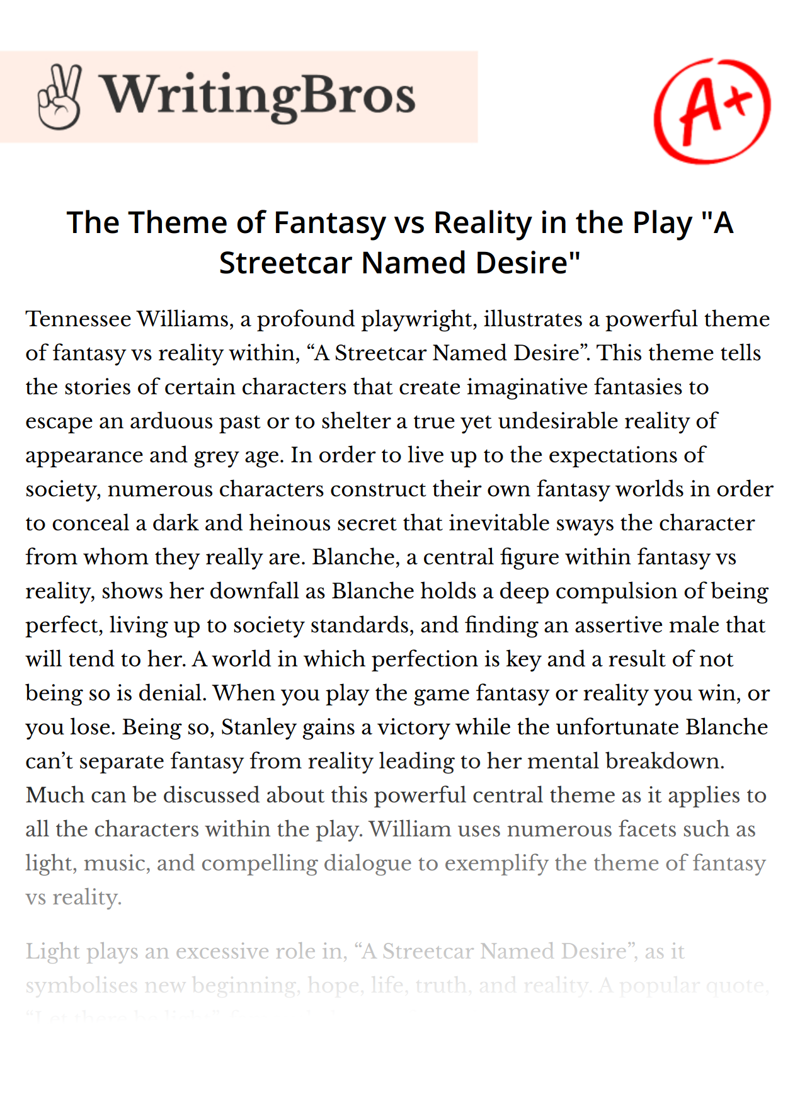The Theme of Fantasy vs Reality in the Play "A Streetcar Named Desire"

Tennessee Williams, a profound playwright, illustrates a powerful theme of fantasy vs reality within, “A Streetcar Named Desire”. This theme tells the stories of certain characters that create imaginative fantasies to escape an arduous past or to shelter a true yet undesirable reality of appearance and grey age. In order to live up to the expectations of society, numerous characters construct their own fantasy worlds in order to conceal a dark and heinous secret that inevitable sways the character from whom they really are. Blanche, a central figure within fantasy vs reality, shows her downfall as Blanche holds a deep compulsion of being perfect, living up to society standards, and finding an assertive male that will tend to her. A world in which perfection is key and a result of not being so is denial. When you play the game fantasy or reality you win, or you lose. Being so, Stanley gains a victory while the unfortunate Blanche can’t separate fantasy from reality leading to her mental breakdown. Much can be discussed about this powerful central theme as it applies to all the characters within the play. William uses numerous facets such as light, music, and compelling dialogue to exemplify the theme of fantasy vs reality.
Light plays an excessive role in, “A Streetcar Named Desire”, as it symbolises new beginning, hope, life, truth, and reality. A popular quote, “Let there be light”, famously known from the bible, describes the light as being good, true to life, and away from darkness (death). In the context of this play, light reveals the ugly perceptions of old age and the imperfections within someone. To Blanche, light is metaphorically a representation of her age and a way for others to see through her for whom she really is. In short, light will not allow her to live within her fantasies. At the beginning of the play, we are introduced to the first interaction between Blanche and light. Stella meets with Blanche for the first time in a while and while they speak, Blanche tells Stella, “turn that over-light off! Turn that off! I won’t be looked at in this merciless glare! (1. 11)”. We are given the first glimpse of Blanche’s idea of light as a merciless unforgiving glare and that speaks to her fear of revealing her appearance without fine groom, ultimately questioning her age.
Furthermore, we notice that Blanche is living in her fantasy world upon arrive to New Orleans as those are one of the first words she spills to Stella. During poker night in scene three, we encounter the notion of dim light directly cuing to Blanche’s age. William starts the scene off by setting the tone and goes on to describe the, “Bedroom [as] relatively dim with only the light that spills between the portieres” (3. 41). The dim light reflects Blanche’s older age and her fear of revealing her true age, although its not enough we can compare dim light as considered old, soon to cease just like an old bulb about to die. In the same scene, Blanche politely asks Mitch to cover a, “a naked light bulb” (3. 54), with a paper lantern. The paper lantern is shown throughout the play as it represents a mask that will hide her insecurities about the past and her matured age. Furthermore, she refers to the naked bulb as, “a rude or a vulgar action” (3. 54), suggesting that she can’t stand reality and the truth of it. Light plays a vital and delicate role within this play and to further construct the theme of fantasy vs reality, William integrates tenacious music.
Music being a delicate element to establish the tone and construct an idea is used seamlessly in the play.
Cite this Essay
To export a reference to this article please select a referencing style below

